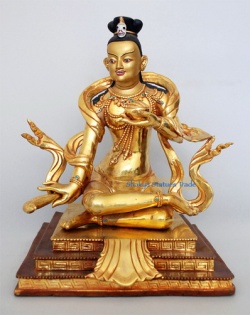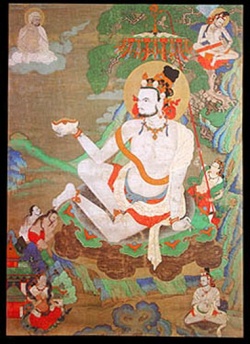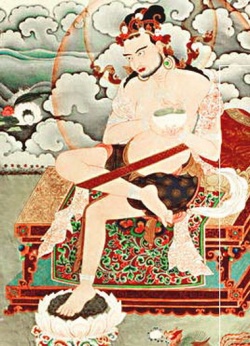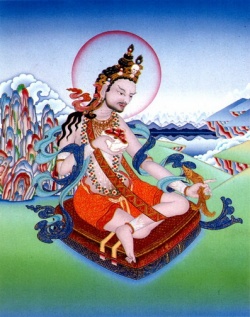The Actual Successive Practice of the Path
This is expounded in two sections: The classifications of the Path; and the instruction of entering into the Path.
There are different ways to classify this teaching—some divide it into two groups; some, into three, four, six, or ten. However, from the viewpoint of befitting the different dispositions or capacities of human beings, the teachings can be classified in three groups. First, the teaching that enables one to become the perfect Buddha in this very life; second, the teaching that enables one to become Buddha in the Bardo state; third, the teaching that enables one to become Buddha in future lives57. From the viewpoint of the nature of the practice, the teaching can be divided into the ordinary Perfecting Yoga, and the outstanding betterment practice of the Perfecting Yoga The latter is not usually found in the teachings of the masters of this school (Kar-gyupa), who mainly depend on the pith-instructions alone.
p. 165
However, those masters in the Marpa school who held the tradition of preaching the Tantra do accept this type of teaching.
Marpa said:
"From the great master Naropa, the guard58,
I have heard the profound Tantra of Hevajra
I also received the pith-instruction of joining, transformation and unification59
(Bsre, rpo, nrtsams-sbyor).
Especially have I learned the teaching of Heat Yoga and Karmayoga.
Thus, for me, was the essence of the teachings of the Whisper Succession illustrated."
Thus, Marpa said, was illustrated for him the joining and transformation practice of the Whisper Succession. In particular, he relied on the practice of the Heat Yoga of the Vajra, which produces the four blisses. Later on, through the practices of Karmayoga, the four blisses were also raised within him. From this we know that, in the teaching of Hevajra, he relied mainly on the Heat Yoga and Karma-yoga.
Again Marpa said:
"In the city of Lagkedar, in the west,
I bowed down at the feet of the holy
Ye-shes-snying-po.
From him I heard the teaching of
Gsun-wa-adus-b’a of the Father Tantra60.
And also received the pith-instructions
Of the Illusory Body and Great Light.
Thus have I learned the teaching of the
Path of the Five Steps."
According to Naropa there are four outstanding Tantras
p. 166
from which the superb pith-instructions are derived; one of them is the teaching of the Path of the Five Steps of Gsun-wa-adus-b’a. Thus Marpa learned the teaching of the Illusory Body and Great Light of Gsun-wa-adus-b’a from both Ye-shes-snying-po and Naropa. As for the teaching of Transformation Yoga and Yoga of Entrance, he mainly derived them from the masterly Gdan-bzhi Tantra.
According to the classification of the Six Yogas of Naropa, the yogas are: Heat Yoga, Yoga of Illusory Body, Light Yoga, Transformation Yoga, Yoga of Entrance and Bardo Yoga. Both the Dream Yoga and Bardo Yoga are ramifications of the Yoga of Illusory Body. It is better to appropriate the Light-of-Sleep61 to the Yoga of Illusory Body; also it is more convenient to classify the Transformation Yoga and the Yoga of Entrance as one. The pith-instruction of Milarepa stated:
"…This teaching contains the Arising Yoga, Head Yoga, Karmayoga, the Knowledge of Reality, the Symbolic Light in the Path, and the Symbolic Illusory Body and Dream in the Path. These six teachings are the heart-like pith-instruction of Marpa, the final teachings of the Whisper Succession. No other teachings of any Path-with-Form can be found superior in essence to these. There is no other temporary or final instruction that does not belong to this teaching. The teaching of the Six Yogas is itself the Perfecting Yoga."
Those who follow and hold the traditional instructions of the Marpa School all hold this opinion. Those who declare that there are other teachings more profound than the Six Yogas of Naropa, speak nonsense.
Here it is proper to point out that, in general, the highest Perfecting Yoga must first provide the method of inducing
p. 167
the [prana] of the Roma and R-kyang62, to enter the Central Channel. This teaching is indispensable, though there are a great many different methods given by accomplished yogis who relied on different Tantras. In this teaching (of Six Yogas), the method of meditating on the [gTummo]62a or the short. Ah at the Transformation Center of the navel is used to gather the Live-Dynamic Prana into the Central Channel. Through the entrance of the air into the Central Channel, the four blisses are produced, and finally, the Mahamudra Innate Wisdom. In this profound Teaching of Skillfulness63 is not relied on, but, instead, the practice of the Samadhi of Absolute-No-Thought, the Yogi will reach the state of Mind-Consolidation in which bliss, illumination, and non-thought are experienced. This state of Mind-Consolidation, however, is a common stage: Hinayana, Mahayana, Paramitayana, and Vajrayana all have the k now ledge and experiences of it. It is by no means special; therefore, it is of great importance that one should not confuse the teaching of this Mind-Consolidation state with the special Tantric Skillful Path. This view can be verified by the instance of Gampopa's [Sgam-po-pa] meeting with Milarepa. When Gampopa first met Milarepa, he told Milarepa that he was able to remain in Samadhi with perfect concentration for many days in a single period. But Milarepa told him that no butter can be produced by squeezing the sand; moreover, the Samadhi he had engaged in was by no means enough. Milarepa then told him that he should practice the Small Ah of Life-Energy of the Heat Yoga. One should well understand this important point64.
We have always heard it said that the teaching of Heat Yoga of the Kargyutpa is the very best; however, this
p. 168
should only be understood to the effect that the primordial and fundamental principle of the Perfecting Yoga is to make the life-prana enter into the Central Channel to produce the Innate Great Bliss. Consequently, as the prime goal is reached, there is no need to pursue any other teachings of the Perfecting Yoga. By the practice of the meditation on the Dumo fire, the air enters into the Central Channel and goes through the progressive process of entering, remaining, and dissolving. By means of this power the Bodhi-Heart is brought under control. No more leakage of the Bodhi-Heart will occur; therefore the Yogi is able to practice the Karmayoga which provides favorable conditions for producing the Four Innate Blisses. The teaching of Heat Yoga and Karmayoga is mainly needed for the purpose of producing the Innate Bliss. Relying on this Innate Blissful-Emptiness while awake, the Yoga of Illusory Body should he practiced in the daytime. At time of sleep in the night, exercise on the Illusory Body of the dream state should be stressed. To practice this, one should first exercise the Light Yoga; then one is able to enter into (and master) the dream. In order to be capable of holding the prana during the time of (the unfoldment of) the Light-of-Sleeping State, one must first have the ability to gather the pranas during the waking state. For both of these practices, the best preparation is Heat Yoga.
The Yogi must first completely master the Dream State. After that he is able to recognize the Bardo State; for this the Heat Yoga is also the best preparation. Also because of the Heat Yoga these three practices converge into the Yoga of Illusory Body.
In the art of mastering the special Transformation Yoga and the Entrance Yoga, one must first be able to gather
p. 169
all the pranas into the Central Channel. Practicing Heat Yoga is the best method to accomplish this.
If he knows the different ways of allocating these teachings, he will have no difficulty in understanding the various ways of classifying them. If he possesses sound understanding of them, he may arrange them in any manner.



